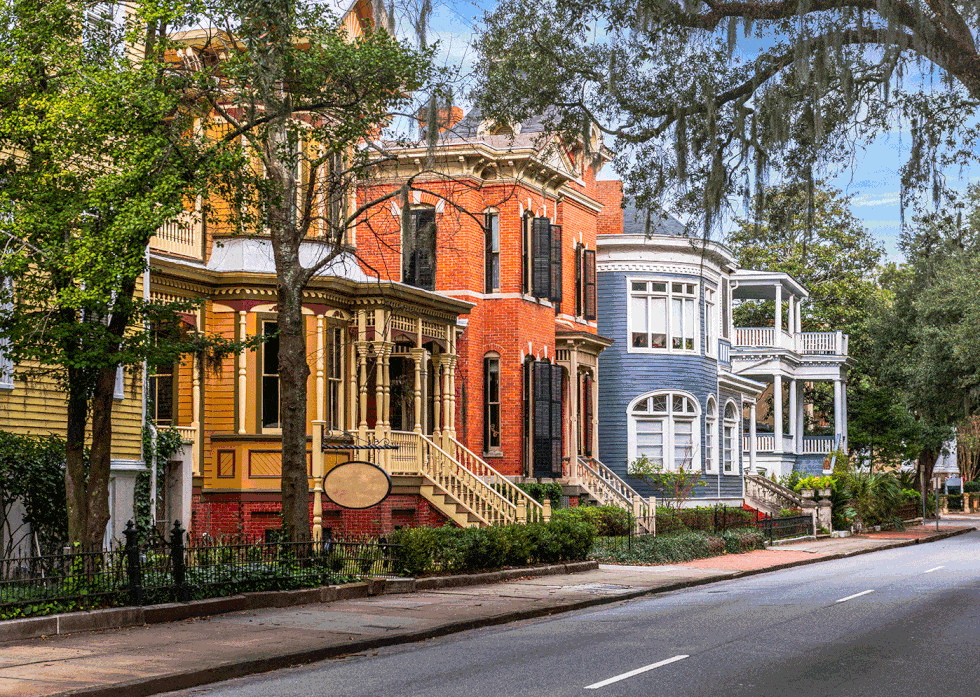A blond, middle-aged man in khakis and a striped polo shirt sits at a grand piano in the middle of the light-filled atrium in the Savannah/Hilton Head International Airport and plays the rambling opening notes of Fats Domino’s classic “Walking to New Orleans.” I feel like I’ve stepped onto a film set as I roll my luggage across the redbrick “town square” and past the storefronts, which are designed in a blend of local Georgian and Southern Gothic Revival traditions and not entirely unconvincing. After descending an escalator out into the gentle spring air, I meet my Uber driver—a gravel-voiced grandmother of two with faded shoulder tattoos—and have my first brush with Southern hospitality.
“If you like an alcoholic drink now and then,” she drawls, a wad of chewing tobacco lodged in her lower lip, “you could do worse than the slushy from Wet Willie’s.” She has my attention. “Doesn’t take but maybe two to get you feeling pretty right,” she adds as she sizes me up in her rearview mirror. She’s from Savannah, she tells me, and used to ride in the St. Patrick’s Day parade. I picture the girl she was on her horse, surrounded by young men from the nearby Fort Stewart Army base, as she describes their faces covered with lipstick from the town women, because it was “good luck to kiss a soldier back in the day!” I note how beautiful and seductive the Spanish moss is as we exit from the highway onto the streets of town. She catches my eye and says sternly, “Don’t lay in it and wallow in it! Don’t want to see you go home with chiggers! Even if you find you a good-lookin’ man! Don’t do it!” But if it were to happen, she swears by covering the bites with clear nail polish, which is, by her estimation, the only way to suffocate said chiggers. (Later research reveals them to be tiny insects that lodge themselves under the skin and cause almost unbearable itching.)
As we pull up to the hotel, I am struck by the sheer, almost perfect beauty of downtown Savannah, dubbed America’s first “planned city” for its gridded streets and copious shaded squares. There is an oft-cited gothic kind of romance in that Spanish moss draped from the trees, cobblestone streets leading to squares upon squares, and the stately Georgian brick houses festooned with fanciful ironwork and stairways that curve into the front door.
More From Oprah Daily

It occurs to me for the first time maybe ever that I’ve traveled all over Europe, Asia, and Africa and yet have barely ventured into the American South. The thing about America is that you can be as close as a two-hour flight away and still arrive feeling like a foreigner—especially when you’re going from the North to the South. And, like with most storied places, our experience of the American South—its charms and fraught history—differs, depending on your particular entry point into the culture, and begs the question of how we behold the beauty of a place head-on without averting our eyes from a complicated past.
The truth is, I was skeptical of the near-breathless pace of the itinerary when I was first invited by New York–based travel specialist Prior to join a three-day trip. Prior, which is well-known in the style, food, and celebrity circles for singular “insider” experiences around the world, was piloting a new program with a group of Capital One’s Venture X card members. In just two and a half days and three nights, we travel, often with cold drinks in hand, through iconic squares of the downtown area, into private dining rooms of restaurants that otherwise require reservations months in advance, and up the stairs of historic houses for private tours not usually accessible to the public. The thoughtful curation of Prior’s team and cofounder and CEO David Prior himself delivers pretty much instantly on the promise of insider access—namely into the heart of the food and art worlds. It is through the chefs and artists putting a distinctly modern stamp on a city that I find my way into this achingly beautiful, if complicated, place.
For the legion of fans of Midnight in the Garden of Good and Evil, yes, our first night there is indeed a private tour of the parlor floor and garden of Jim Williams’s beautifully restored Mercer Williams House. Each room’s color, mixed by Williams himself, recalls the house’s original look. I can almost feel Williams’s guests at his famous parties in the 1970s and ’80s brushing past me as I take in his collections of everything from china plates recovered from a famed shipwreck to brilliantly sourced sculpture, paintings, and even taxidermy.
We follow our tour guide—a tall man with a porkpie hat and details about Savannah’s (and Georgia’s) founder, James Oglethorpe, at the ready—through the squares and into the other houses as he recounts the history behind the War of Independence statuary and the influence of the Freemasons throughout the architecture and city planning. In true Southern fashion, we are greeted at every stop with a delicious Chatham Artillery punch, a Savannah staple that adds the triple threat of cognac, rum, and bourbon to a champagne base in an oddly refreshing blend.
By the time we arrive at our private room at Mashama Bailey’s The Grey, the group is in high spirits. The James Beard award-winning chef, who greets us with a giant smile, is poised, not unlike a dancer or a toreador before a big performance, but with the ease of someone who loves what she does. Housed in a 1938 Greyhound bus station, the space itself—with its soaring ceilings and polished Art Deco details—is a marvel. We gather in the Diner Bar part of the station, tucking into windowed, tufted leather booths facing a long countertop. There is not a single dish that does not shine on its own. In one standout, Bailey updates the classic Southern staple of grits with seared foie gras, and in another, her crudo with green Caesar mayo, croutons, and herbs balances freshness with just the right amount of tangy creaminess and texture. Bailey grew up primarily in New York City but spent much of her childhood with her mother’s family in Georgia and traces the roots of her cooking lineage to time in the kitchen at her grandmother’s house in Queens. Given the opportunity, after formal training at ICE and cooking with mentors like Gabrielle Hamilton at New York’s legendary restaurant Prune, Bailey came to Savannah to partner in The Grey. From the beginning, her vision was clear: a soulful update on Port City Southern food, with an emphasis on seasonal and regional ingredients. Hanging in a hallway in the restaurant, there is a framed Greyhound bus first-aid kit, which belonged to Bailey’s grandmother, who was a licensed nurse in the 1960s. It honors just how far the celebrated Black female chef has come since Savannah’s desegregation in 1963.
Friday morning kicks off with a tour of the Bonaventure Cemetery, which was founded in the mid-19th century on a former plantation by the Wilmington River. Our guide looks like a cross between the rock singer Meat Loaf and, in his period black morning coat and matching waistcoat, a Dickensian soothsayer. With theatrical flourish, he regales us with stories of the lives and deaths of Savannah’s native sons and daughters, like crooner Johnny Mercer (of “Moon River” fame) and writer Conrad Aiken, and directs our attention to the alignment of obelisks and the evidence of entire Masonic libraries in crypts deep below the surface. Our guide points to small iron hooks, some of which still have bells attached to them, tucked in behind some gravestones. Years ago, he claims, the bells were attached by string to the body of the deceased, just in case they, well, weren’t quite dead.
After a communal luncheon under the Southern live oaks at Chatham Square, we set out into the Downtown Design District, where the Prior team has curated an impeccable list of antique, vintage, and contemporary design shops for us to explore at our own pace. My favorite is V & J Duncan Antique Maps on Madison Square, where rooms spill into rooms of an 1850s townhouse, each one piled high with antique prints, maps, and books. Asher + Rye, which is located in a beautifully updated old gas station on Whitaker Street, sells a handpicked selection of furniture, housewares, and clothing from Scandinavian, Japanese, and American designers and artisans.
Following a much-needed disco nap, we dress for dinner and hop onto an old trolley car to Reynolds Square for dinner at the Olde Pink House, one of the few remaining 18th-century mansions so-called for the pink cast of the red brick bleeding through white stucco. Midway through dinner, a woman dressed in full skirts and a cinched 18th-century-style bodice waltzes in, fan in hand, to ask if we want a song. As she opens her mouth and starts to sing Otis Redding’s “The Dock of the Bay,” all of us freeze, awestruck by her rich vibrato. After our applause dies down, she invites a brave enough soul to sing with her for the next song. One of the men in our group, a Black man in his 50s from Florida who is here with his husband, shyly volunteers, then retreats. When pressed, he says he’ll sing with her if we turn the lights down. Someone jumps up and turns them low. They’re an odd couple, she in her 18th-century finery and he in tan shorts and a pastel shirt. With one hand pressed nervously to his leg and the other to his heart, he begins to sing “Amazing Grace.” She watches him closely, tapping her fan against her hip, and a few bars in, she unfurls it and joins him in perfect harmony. It occurs to me as I look at the expressions on the faces of my fellow travelers that what could easily have been dismissed as tourist kitsch is, instead, a transcendent moment. And, of course, the irony of two perfect strangers singing one of the most enduring anthems of hope in a home built at the height of slavery isn’t lost on any of us.
Saturday morning we set out to visit the Savannah College of Art and Design, known widely and affectionately by its acronym, SCAD. SCAD has not only emerged as one of the country’s best art and design schools but also is beloved for its part in the regeneration and preservation of downtown Savannah since its purchase of a single brick building on Bull Street in 1979. After brunch and drinks at the university’s museum, Kristin Poitras, who is the director of museum programming and operations, and a student docent lead us on a private tour of the impressive collection, the highlights of which were installations from New York sculptor Rachel Feinstein, Moroccan photographer Hassan Hajjaj, and young painter Chase Hall’s stunning debut exhibition.
From SCAD we head to our lunchtime destination, Back in the Day Bakery. Cheryl Day, the doyenne of Southern baking, is your friend. Within 10 seconds of meeting me, she alerts me to the fleck of kale stuck in my teeth. Then after I repeatedly scrape at the wrong crevice, she guides my finger with hers toward the right one. After you spend the morning with her, the important truth you come away with is that real biscuits, at their very finest, are the American croissant. We are there not only for a private lunch but to learn from the master. Day carries us through our cutting-in of cold butter and layering with an ease that teaches sense and feel alongside precise measurements. A group of grown-ups kneading and folding dough makes for a very happy room and lots of laughter. The fruits of our labor culminate in the form of BLT biscuit sandwiches slathered in house-made mayo, thick cuts of bacon, and fresh-from-the-vine tomato, which we wolf down with ice-cold Georgian sweet tea.
Carrying bags filled with treats from Day’s shop, I walk from square to square, determined to work up an appetite for the final dinner. By now I have a rough sense of where I am in relation to the hotel. I let myself wander, looking down alleyways with climbing vines tumbling from back terraces and up at the statues that anchor each square, which are mostly of men on horses celebrated for their Revolutionary War heroics. The tours we have been on, as amazing as they are, elide mention of the history of slavery in Savannah— maybe because it is so thoroughly interwoven, or perhaps out of fear that anything good would be eclipsed by the indisputable horrors. As a German citizen who has now spent the bulk of her life in America, I can understand that ache and shame, and the fear that the evil-good binary will somehow strip, in the case of Germany, the mountains and the rivers of their beauty or the writings and music of their poetry. And on a deeply personal level, that one’s own warm and fuzzy nostalgia for a place cannot coexist with not-so-distant past horrors. But I can say from experience that there is great liberation in acknowledgment and humility. And being of a place that has elevated reparations to official policy and requires fact-based history as curriculum, I can also attest to how much it unifies, rather than divides.
Histories of place are not unlike those of families in terms of their repetition and denial and require those rare brave creative souls to disrupt patterns. I think about how Southern food, as we understand it today, has its deepest roots in the traditions of the enslaved and their descendants, who cooked in the kitchens of wealthy whites while paradoxically establishing the most beloved of traditions from whatever scraps were left. Both Day and Bailey, two major African American chefs, talk openly about the significance of representation and about making food that takes the best of both African American and European American traditions and tells a full story. Of being the face of the place and not just the invisible background. Significantly, both chefs are committed to the mission beyond their own enterprises. Bailey serves as chair of the board for the Edna Lewis Foundation, a nonprofit that honors the legacy of its namesake by awarding grants to African Americans in the fields of cooking, agriculture, food studies, and storytelling. Day, who has also collaborated with Bailey on Edna Lewis events, is a cofounder of Southern Restaurants for Racial Justice. Similarly, Chase Hall’s beautiful and moving exhibit at SCAD shows us new ways for people to experience and claim their roles. To wit: Accompanying the paintings are quotes on the walls from community members with personal insight into the scenes and figures depicted in the paintings. Beside one painting titled Cooking with Gas, which depicts four Black chefs cooking, is a poignant quote from a female cafeteria cook that sort of says it all: “To see us cooking in the places where we couldn’t even go in to sit, not even look in the windows. It’s bringing back a lot of memories about where we’ve been and where we are still going.”
For our last night, Holley Jaakkola and Felicia McManamy, co-owner of the inspired garden and floral design firm Moss & Vine, host us at Jaakkola’s 1850s Federal-style waterfront home on the Isle of Hope. About eight miles outside downtown Savannah, it is an inland peninsula where affluent Savannahans began summering in the 1840s as a retreat from the city heat. The stately house has double-decker wraparound porches and pillars flanking the doorway. As we meander through the rooms, each a veritable cabinet of wonder, and into the backyard, a young man, early 30s with shoulder-length hair, sits on a tree stump just off to the side from a fire pit where oysters roast in a burlap sack on a black iron tray. Sitting under a majestic live oak draped with the still-beguiling Spanish moss, he strums the guitar and sings wistfully. His song and timbre captures that bittersweet mix of lightness and long-suffering that has become synonymous to me with the South. Which is to say, you sneak in the hard stuff with the sweet songs. With more cocktails in hand, we move to the roasted oysters on saltines with fresh horseradish and the best hot sauce I’ve had in my life. That was just the appetizer. Piled on a giant slab of plywood with a hole in the middle for empty shells is a classic Low Country boil with heaps of Old Bay–seasoned shrimp, andouille sausage, and potatoes. I have to laugh as the man teaching us to shuck our roasted oysters tries, in vain, to caution us to save our appetites for the whole hog barbecue that chef Brandon Carter and his team from Common Thread have been cooking all day in a giant iron smoker out back. Once the pork is ready, I am inexorably moved to go for a sampler because one cut looks more delectable than the next. The man apportioning pieces gives a knowing laugh as I gesture for him to add more to my plate. I take my bounty inside and settle in beside the man from Florida who sang for us the night before. He tells me of his work with a Covid response team in Broward County. He is Black and gay—his husband is at the next table—and identifies as right-of-center to my left-of-center. We share experiences and thoughts—if not political views—genially enough, and can both agree that this spread from the Common Thread team is like no other BBQ either of us has ever tasted. I am well into my second serving when a member of our party dashes in, beckoning us back outside. “The songs are so good; the night is perfect,” she says. “You can’t miss this!”
I step outside to find our group sitting under a canopy of Spanish moss on scattered tree stumps transfixed by the singer, Jalen Reyes, who in his seasoned, warm tenor sounds a little like a Georgian Jeff Tweedy. The sky is pitch-dark now, the only sources of light coming from stars, twinkling bulbs strung loosely on the branches of the live oaks, and the smoldering embers leftover from the oysters. At our urging, he has moved from well-loved covers of Southern hits to acoustic versions of his own songs, beautifully wrought stories of loss, regret, love, and redemption. Reyes’s straight, dark hair is tucked behind his ears, and he cradles the guitar like it is an extension of his own body; he seems to be both in his own world and singing directly to each of us. To my left, I see the shoulders of a young woman in front of me start to shake, and just ahead, another woman wipes her eyes. The Australian man to my right has tears rolling down his face.
Something magical has happened. The alchemy of the coastal breeze, the ever-present hanging moss, the loving hand in the food and drink at every turn, sets each of us on our own journey with Reyes and his song. We are no longer passing through Savannah; in some way, we feel we are, briefly, of it.
The new Prior and Capital One joint venture offers cardholders a complimentary Prior subscription to trip-planning services and content as well as access to exclusive cardholder trips.
This post was originally published on this site be sure to check out more of their content.







